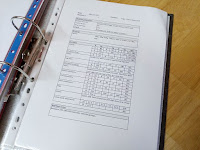One of the most important things anyone serious about exercising needs to do is write a journal! Whether you only write a few lines or a whole essay writing a workout journal is quite possibly one of the best things you can do.
Table of contents
Why to keep a record?
Whether you work out once a week, five times a week or whatever, it becomes harder to remember what you did in previous sessions, especially when you really mix things up. You may end up doing the exact same amount of work as the last time or maybe even less and not realise it until afterwards.
Writing a journal also allows you make comments about how you felt during the exercises, what you liked, didn't like, amongst many other things.
You can write anything you wish about your workout, for example say: what weight you are, the weight, sets and repetitions of each exercise, the tempo of each rep, the rest time between. The amount of distance covered and calories burnt on a cardio machine. Whether you felt you had less energy after a poor sleep. You felt too bloated after eating too much earlier in the day and it impacted your workout, etc. etc. The limit is what you wish and feel you need to record.
It really is a good habit to record what you do. It also makes tracking progress a hell of a lot easier as you can simply flip backwards and see what you had done. This makes it easier to plot your future workouts.
If you go to a personal trainer they should be recording what your doing and the acute variables being used anyways, however you can make you own notes to compliment or augment what they have.
So how do you go about it?
Medium
Grab a note pad, note book or even loose paper. As long as you have enough space to record what you want it will suffice. The only thing that truly matters here is how you store it.
- If you are using a note pad, make sure you date the workout to ensure you keep everything in order.
- Depending on the note book, I would suggest using a dairy or daily planner, with one day per page. This allows you to record quite a lot of information on a single page (depending on your format) without having to write into other days.
- If you use loose paper then I highly recommend putting the date on the page! You wouldn't believe how frustrating it is to find a piece of paper with a workout on it and no date and you're not exactly sure where it fits in with everything else.
- I personally have two journals that I use simultaneously. One is big note book that I use for scribbling my workouts as I do them. The other is a daily planner note book that I write my workouts into afterwards in a neater and better laid out format. You don't have to do this, but I like to.
In regards to using loose paper, whilst it suffices to get the workout recorded, it would be ideal to have a note book where you can write it into afterwards. Nothing worse than having loads of loose paper lying all over the place. A note book is a lot tidier, neater looking and can be easily filed on a bookshelf.
Format and layout
What format should you use when writing your journal? That is entirely up to you. As long as you know what it means then that is all that matters. You can be pretty fancy in your formatting and layout or as simple as you want, it doesn't matter as long as it suffices for you.
The one thing I would implore is to write as neatly as possible, especially if quickly jotting it down onto a piece of loose paper. Sometimes, especially if you have little time between sets or exercises and want to make a quick note you end up scribbling something that you can't make out later. It can feel like code-breaking and you won't always be successful. It doesn't have to be perfect, it just needs to be understandable.
I've in the past even thought it wise to record my workouts in a fancily laid out spreadsheet, printed off, popped into poly-pockets and into a ring folder. It looks good and professional, however it was time consuming and I have since opted for good old hand-writing into a note book. But if you prefer to go this way then by all means do so.
Gallery
Below is a small slider of my own personal journals, styles, and formats from over the years.
Key points recap
So the key points to remember when keeping a workout journal:
- Ideally use a note book, especially a daily planner.
- If using a note pad or loose paper, record the date on it!
- If using a note pad or loose paper, preferably write it into a note book afterwards.
- Try to write it as neatly as possible so you can understand what you have written.
- Format it in a way that you are happy with and can understand.
- Record as little or as much as you need.
I hope this has helped you decide to get a record of your exercising. It really does help in the long run. If you have any questions feel free to comment below or send me some feedback!
Lyle Richardson,
Gym Pal - Your friend in the world of fitness








0 comments:
Post a Comment